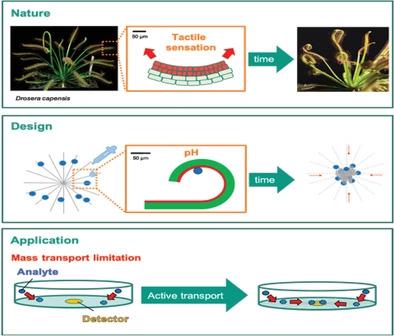当前位置:
X-MOL 学术
›
Adv. Funct. Mater.
›
论文详情
Our official English website, www.x-mol.net, welcomes your
feedback! (Note: you will need to create a separate account there.)
Directed Particle Transport via Reconfigurable Fiber Networks
Advanced Functional Materials ( IF 18.5 ) Pub Date : 2022-06-22 , DOI: 10.1002/adfm.202204080 Katharina Cu 1 , Anke Steier 1 , Marvin Klaiber 1 , Matthias Franzreb 1 , Joerg Lahann 1, 2
Advanced Functional Materials ( IF 18.5 ) Pub Date : 2022-06-22 , DOI: 10.1002/adfm.202204080 Katharina Cu 1 , Anke Steier 1 , Marvin Klaiber 1 , Matthias Franzreb 1 , Joerg Lahann 1, 2
Affiliation

|
Mass transport limitations of particulates within conventional microanalytical systems are often cited as the root cause for low sensitivity but can be overcome by directed analyte transport, such as via biomolecular motors or gradient surfaces. An ongoing challenge is the development of materials that are passive in nature (i.e., no external power source required), but can reconfigure to perform work, such as transporting particle-based analytes. Mimicking biology's concepts of autonomous and reconfigurable materials systems, like the Drosera capensis leaf, reconfigurable fiber networks that effectively concentrate particulates within a localized spot that can act as a detection patch are developed. These networks, prepared by electrohydrodynamic co-jetting, draw their reconfigurability from a bicompartmental fiber architecture. Upon exposure to neutral pH, a differential swelling of both fiber compartments gives rise to interfacial tension and ultimately results in shape reconfiguration of the fiber network. Compared to free particles, the reconfigurable fiber networks display a 57-fold increase in analyte detectability, average transport efficiencies of 91.9 ± 2.4%, and separation selectivity between different surface properties of 95 ± 3%. The integration of biomimetic materials into microanalytical systems, exemplified in this study, offers ample opportunities to design novel and effective detection schemes that circumvent mass transport limitations.
中文翻译:

通过可重构光纤网络进行定向粒子传输
传统微分析系统中颗粒的传质限制通常被认为是灵敏度低的根本原因,但可以通过定向分析物传输来克服,例如通过生物分子马达或梯度表面。一个持续的挑战是开发本质上是被动的(即不需要外部电源)但可以重新配置以执行工作的材料,例如传输基于粒子的分析物。模仿生物学的自主和可重构材料系统的概念,如毛毛霉叶,可重构的光纤网络可以有效地将颗粒集中在一个可以作为检测贴片的局部点内。这些通过电流体动力共喷射制备的网络从双室纤维结构中汲取了可重构性。在暴露于中性 pH 值时,两个纤维隔室的不同膨胀会引起界面张力,并最终导致纤维网络的形状重新配置。与自由粒子相比,可重构纤维网络的分析物可检测性提高了 57 倍,平均传输效率为 91.9 ± 2.4%,不同表面性质之间的分离选择性为 95 ± 3%。本研究举例说明了将仿生材料整合到微分析系统中,
更新日期:2022-06-22
中文翻译:

通过可重构光纤网络进行定向粒子传输
传统微分析系统中颗粒的传质限制通常被认为是灵敏度低的根本原因,但可以通过定向分析物传输来克服,例如通过生物分子马达或梯度表面。一个持续的挑战是开发本质上是被动的(即不需要外部电源)但可以重新配置以执行工作的材料,例如传输基于粒子的分析物。模仿生物学的自主和可重构材料系统的概念,如毛毛霉叶,可重构的光纤网络可以有效地将颗粒集中在一个可以作为检测贴片的局部点内。这些通过电流体动力共喷射制备的网络从双室纤维结构中汲取了可重构性。在暴露于中性 pH 值时,两个纤维隔室的不同膨胀会引起界面张力,并最终导致纤维网络的形状重新配置。与自由粒子相比,可重构纤维网络的分析物可检测性提高了 57 倍,平均传输效率为 91.9 ± 2.4%,不同表面性质之间的分离选择性为 95 ± 3%。本研究举例说明了将仿生材料整合到微分析系统中,











































 京公网安备 11010802027423号
京公网安备 11010802027423号